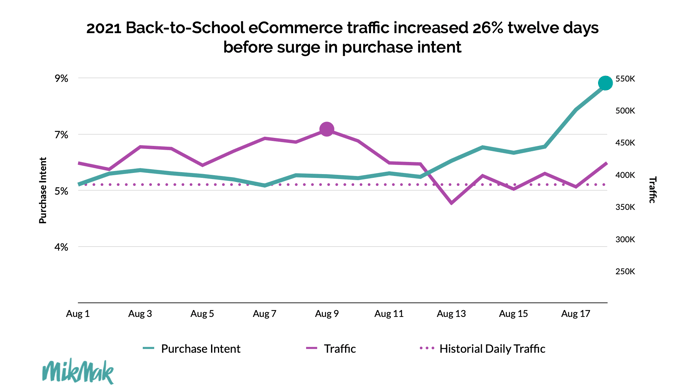
Shopping lists come in many forms. For birthdays and holidays, there are gift lists. For households, there are grocery lists. For retailer-driven occasions like Prime Day, Back-to-School shopping, Black Friday and Cyber Monday, consumers may build even longer lists to maximize their savings.
So how does your product make it into your consumer’s shopping lists, particularly for the holidays? Here are some insights from Back-to-School shopping that can help brands prepare for one of the largest shopping occasions in the US.
Getting on the shopping list is half the battle
Retailer-driven shopping occasions often have dates where anticipated discounts occur. Prime days and deal days, Back-to-School specials, and winter Holiday deals take place as announced by the retailers hosting them. With annual occurrences, shoppers begin to anticipate them and plan purchases — and thus shopping lists — accordingly.
Marketing leaders like Kellogg’s Gail Horwood understand that much of commerce is about making it onto “The List,'' and knowing how to do so. When consumers add products onto shopping lists, they exhibit high intent to purchase those items. Even when included as an afterthought, items on lists are more likely to be purchased.
What does “purchase planning” look like?
With a slew of major shopping peaks right around the corner, brands should ensure they are discoverable at least a month prior to the big season. Being discoverable one month out lets your product become familiar and top of mind for purchase-planning shoppers. However, the active window when it comes to getting on shopping lists is around ten days before the deals begin.

MikMak’s Shopping Index sampled over 5 million Back-to-School shoppers through our eCommerce analytics and enablement platform this year, and found that online shopping traffic from August 1 to August 12 increased as high as 26 percent above an average of 348K daily shoppers without significant change in purchase intent. Then, from August 13 to August 18, purchase intent surged. This means consumers were "list building" and window shopping online ads, but waited to buy.
If you are tracking shopping traffic and purchase intent for your brand, this is what a “purchase planning” and “list building” period looks like. First, a period of increased shopping traffic without changes in purchase intent, which tends to sustain around ten days. Then, a surge in purchase demand.
How to get on shopping lists for the holidays
When building shopping lists, consumers are actively planning their spending. For large scale, cross category discount events that occur up to the winter Holidays, shopping lists for different needs may even merge into one. The holiday shopping list may not only consist of gifts for others, but also for personal use and pantry stocking.
With large events like Black Friday and Cyber Monday, shoppers know that products run out of stock quickly. Billie Hirsh, Kargo’s VP of Marketing, mentions that this year “consumers are now aware of issues within the supply chain and are likely to shop earlier than ever to make sure their gifts arrive on time.”
Depending on your product, consumers will be doing their discovery, research, and purchase planning for at least a week and even up to a month before purchase. They’ll be comparing not just product specs but also where they plan to buy and ship or pick up from. When deals are taking place across multiple retailers, omnichannel factors such as fulfillment options, delivery time, and price, will play into where the final purchase is made. Here are some strategies to consider in order to get on shopping lists:
1. Offer shorter paths to purchase by making awareness campaigns shoppable
Brands should always be looking for opportunities to shorten paths to purchase, and one way to do so is by making awareness media shoppable. Particularly during this high traffic time, shoppable awareness campaigns give consumers the flexibility to choose to purchase or plan a purchase if they are ready.
2. Partner with adjacent brands to drive bigger baskets
When shoppers are in a list-building mindset, especially when anticipating discounts or a major gifting occasion, they tend to err on creating a larger and more expansive shopping list. That means your consumers want to buy you with other products. Like peanut butter and jelly, tequila and guacamole, home care and pet food, a partnership between your brand and another may make sense for your shoppers, and get you some easy wins as you get added onto shopping lists adjacent products are on.
3. Encourage shoppers to start lists with what they already use
Don’t only rely on product recall at cart to drive sales. Instead, give your shoppers more tangible ways to remember you. Whether through omnichannel marketing strategies like coupons, or through social platforms conducive to building shopping lists like Pinterest, give your shoppers a reason to print, save, or share your ads.
Ready to get on some shopping lists ahead of this Holiday season? There’s plenty of time to get started. So keep your eyes on your eCommerce dashboard and prepare your strategies for when these surge moments occur to make the most of the rest of 2021.


